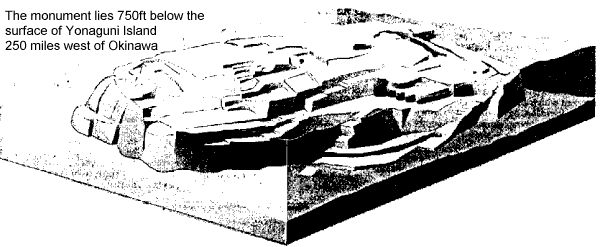 |
Science Frontiers ONLINE No. 118: Jul-Aug 1998 |
|
|
Astounding Undersea Structure Near Okinawa
"A structure thought to be the world's oldest building, nearly twice the age of the great pyramids of Egypt, has been discovered. The rectangular stone ziggurat under the sea off the coast of Japan could be the first evidence of a previously unknown Stone Age civilization, say archeologists."
Wow! Is this true? This so-called "structure" is 600 feet long and 90 feet high. Said to be about 10,000 years old, it obviously predates the edifices of the ancient Egyptians and Babylonians. The "structure" is now under about 75 feet of ocean near a small island named Yonaguni southwest of Okinawa. During the Ice Ages, it would have been exposed, just like the Bering Land Bridge to the north.
Of course, the crucial question is: Is it really artificial? R. Schoch, the Boston University geologist who vouches that the Sphinx is also about 10,000 years old (SF#79), described the "structure" as a series of huge steps about 1 meter high. Schoch is impressed by the regularity of the steps, but does not discount a natural origin.
A photo taken by divers does reveal a remarkably regular, stepped surface, but nature can be very methodical on occasion. Adding to the artificiality of the "structure" is the claim that a "road" encloses it.
(Barot, Trushar; "Divers Find World's Oldest Building," London Times, April 26, 1998. Cr. A.C.A. Silk & D. Phelps)
Comments. If this submerged "structure" is really man-made, it would make Hapgood's Maps of the Ancient Sea Kings more plausible.
Other nicely regular "structures," very likely natural, are: the Giant's Causeway, the Bimini Road, the Kaimanawa Wall, the Face on Mars, etc.
 |
| Called a "monument" by some zealous explorers, this Okinawan undersea structure does exhibit many suspicious regularities. Nevertheless, nature is often a geometer, and this could be a natural geological formation. (Adapted from the London Times). |